In the early 16th century, a Roman coin bearing the image of a crocodile chained to a palm branch was unearthed at Nîmes in the south of France. On the obverse were profile portraits, back to back, of Octavian (later the emperor Augustus) and his general, Marcus Agrippa. The coin, a bronze dupondius, had been struck in 28BC to commemorate the pair’s victory over Antony and Cleopatra at the Battle of Actium three years before – the crocodile representing Cleopatra and Egypt, the palm a symbol for victory. Above the reptile were the letters ‘COL NEM’, abbreviations for ‘Colonia Nemausensis’: this city of southern Gaul lay strategically on the Via Domitia, the route that linked Italy with Spain, and having been conquered by the Romans in the second century BC, in 44BC Nemausus (to give Nîmes its ancient name) had been made a colony.
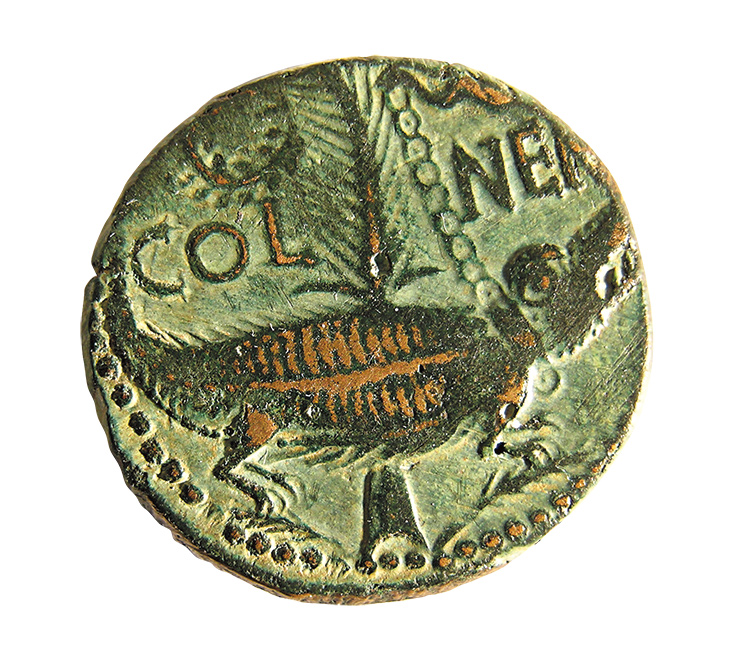
‘As de Nîmes’ dupondius coin, verso showing a crocodile chained to a palm branch, issued under the reign of Augustus (27 BC–14 AD). Musée de la Romanité, Nîmes
Soon after the rediscovery of the ‘As de Nîmes’, as the coin became known (from the Latin aes, ‘bronze’), Francis I authorised the city to adopt the crocodile and the palm tree as its emblem. And indeed as you walk around the city today, you see it everywhere: picked out in gold on the elaborate ironwork doors of the Hôtel de Ville (where inside, just for good measure, four stuffed crocs dating from the 16th to 18th centuries are suspended from the ceiling); on drainpipes, streetlamps and – in an updated version from the 1980s by the designer Philippe Starck – on brass discs set into the paving stones. An arrestingly lifelike bronze crocodile lurks in a fountain in the Place du Marché, and the city’s football team is nicknamed Les Crocos.
This is a city whose Roman legacy is a highly visible part of its everyday life; not for nothing did tourist posters from the 1950s advertise it as ‘La Rome Française’. The so-called Maison Carrée occupies what was once part of the ancient forum, now an elegant French square still at the heart of the city, and lined with cafés and boutiques. Thanks in part to its continued use over the centuries – as a church, stables, even a museum of fine arts – this Augustan temple is, aside from the Pantheon in Rome, the best-preserved religious building of the Roman world. Elsewhere, the city’s ancient ancestry is announced in a gleaming 19th-century statue of the emperor Antoninus Pius, whose family is supposed to have come from Nîmes; in the neoclassical temple that is the Palais de Justice; in the stone remains of an old Roman water tower, which distributed water brought to the city via the Pont du Gard some 20km north-east; and, for instance, in disparate classical sculpture fragments embedded on a street corner to make a bearded man with a female torso and four legs – a strange assemblage resembling an ancient game of Consequences. Above all, Nîmes’ classical past is writ large in its great Flavian amphitheatre, the best preserved in France, which serves its original purpose as a venue for mass entertainment with regular bullfights, concerts and re-enactments of ancient Roman games. And now, facing the amphitheatre itself, is a new museum dedicated to the civilisation responsible for so much of the city’s identity.
Opened last summer after a €59.5m project, the Musée de la Romanité stands swathed in an undulating façade made up of 7,000 glass tiles, the overall effect intended to resemble the fabric of a toga. The building’s French-Brazilian architect, Elizabeth de Portzamparc, was also making reference to the Roman mosaic tradition when she chose this unusual cladding. What with the use of transparent and reflective material, De Portzamparc has pulled off the difficult trick of making an architectural statement without eclipsing or compromising the museum’s ancient neighbour. (It’s not the first time such a juxtaposition has been made in Nîmes. On one side of the square occupied by the Maison Carrée is a museum of contemporary art designed by Norman Foster in 1993, the four piers of its vast portico echoing the Roman temple’s columns, and its glass exterior divided into panels that evoke the ashlar masonry of the ancient building’s walls.) More than that, the new museum is part of its urban surroundings in a very real way: slicing through it at street level is a large public walkway that now links the Boulevard des Arènes to an archaeological garden at the back of the building and to the rest of the town beyond. There’s a spectacular roof garden, and the requisite museum restaurant at the top, too (already encouragingly busy on a weekday lunchtime in winter). From most places in the museum there’s a view, or at the very least a teasing slice of a view through openings in the ‘toga’, back to the amphitheatre.

Cinerary urn (Roman era). Musée de la Romanité, Nîmes
The Musée de la Romanité has been long in the making, at least since its initial conception. A selection of the city’s Roman artefacts had previously been displayed in a 17th-century Jesuit college – along with the taxidermied wildlife of the city’s natural-history collection. Even had Nîmes’ archaeological collection remained static, there would inevitably have been calls to construct a museum building better suited to modern methods of conservation and display. But new finds are made in the area constantly (for all the material already uncovered, only a fraction of the ancient city has been investigated). In 2007, a significant archaeological discovery in the centre of town increased the urgency for an updated, much larger museum. Preceding the construction of an underground car-park on the Avenue Jean Jaurès, an excavation overseen by the Institut National de Recherches Archéologiques Préventives (Inrap) uncovered, among other things, two large mosaics dating to the 2nd century AD. Exceptionally well preserved and of outstanding quality, they came from what was clearly a wealthy private house in a residential district of the ancient city.

The ‘Pentheus’ mosaic (2nd century AD), excavated 2006–07 on the Avenue Jean Jaurès. Musée de la Romanité, Nîmes
One of those mosaics, covering 35m2 of floor space, is now displayed as the star exhibit on the second floor of the new museum, reached via a central swirling staircase of aluminium and glass. With a large border, part of which resembles chequerboard tiles, the mosaic proper features medallions of theatrical masks, personifications of the seasons, and birds including ducks, partridges and hoopoes. They surround five main panels, in fluid cross-shapes: four maenads or bacchantes, each clutching a tambourine and a thyrsus, and at the very centre, a kneeling man being speared by a woman. The figures have been identified as Pentheus, king of Thebes, and his mother, Agave, in the climactic event of Euripides’ Bacchae, in which Agave and her followers mistakenly kill her son in a Bacchic frenzy. Is this a humorous warning, in the reception room of a Roman domus, against the excesses of alcohol? Or perhaps, conversely, against resisting the Dionysian experience, as Pentheus did? Whatever its significance, such a theme proclaims the cultural sophistication – or pretensions – of the house owner. This is a rare literary subject for a decorative scheme: while there’s a wall painting on the same theme in Pompeii, this is the only known mosaic to depict this particular scene.
The ‘Pentheus’ mosaic is one of some 5,000 objects on display here – an impressive amount, though still only a fifth of the museum’s holdings. And that number will grow. As the museum’s chief curator, Dominique Darde, explains: ‘Preventive archaeology is extremely dynamic in Nîmes, with well-appointed teams – principally that of Inrap. There will certainly be more discoveries in the years to come. The museum has to transmit these to the public as fast as possible; that’s our role.’ She continues: ‘A space is planned in the museum layout to relay the findings of excavations in the town and its environs. Of course, it will have to be regularly updated. This subject is important to me, as I’m an archaeologist by training. We must show that knowledge is not fixed.’
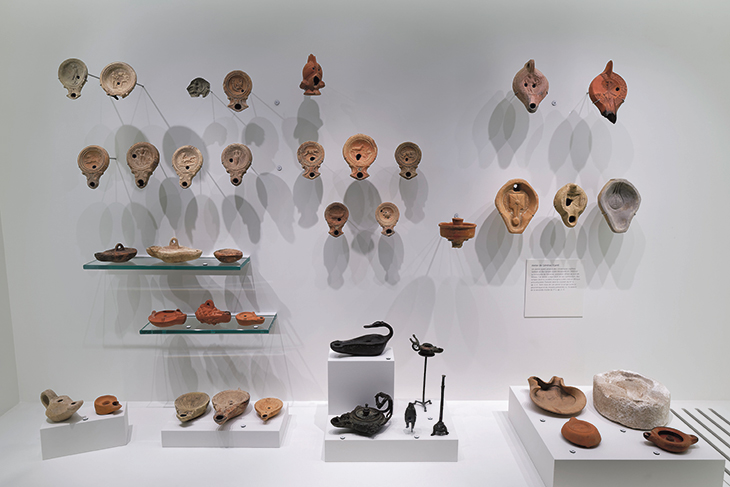
A display of decorated oil lamps – used for both everyday lighting and ritual practices – in terracotta and bronze (Roman era)
The galleries themselves are divided into four main sections: Pre-Roman, Roman, Middle Ages (which includes some beautifully carved stones from a church in the medieval quartier that grew up inside the amphitheatre itself, before being cleared in the 18th century), and Legacy. This last is a pleasingly eccentric section devoted to three 19th-century collections that formed much of the original core of the museum’s holdings. One of these comprises scale models of great Roman buildings sculpted in cork by Auguste Pelet, a Nîmes businessman-turned-classical-enthusiast who showed these miniature monuments at the Universal Exhibition in 1839. It’s interesting to see how the Nîmes amphitheatre compares to the Colosseum – smaller, needless to say, but not by such a long way. The level of detail carved on these models makes them a genuinely valuable record: much of that detail has since been lost on the buildings themselves.
‘We must not forget about the Gauls,’ Daniel-Jean Valade, Nîmes’ deputy mayor for culture, tells me. And the museum certainly hasn’t. The Gallic settlement of Nemausus had grown up at the end of the sixth century BC around a woodland spring to the north-west of what is now the town centre, at the foot of the hill known as Mont Cavalier. The pre-Roman section of the museum features a reconstruction of a Gallic house from the fifth century BC, based on remains found in the area in the 1970s. Also displayed are rare Gallo-Greek inscriptions on funerary steles. Being so close to Marseilles, the southern Gauls had trade contact with the Greeks, and, having no written language of their own, used the Greek alphabet to write the Gallic words they spoke. Rare figurative works have been found on various sites, including an Iron Age limestone male bust from Sainte-Anastasie – a village north of Nîmes – thought to represent a heroic warrior (7th–6th century BC).

Bust of a man (7th–6th century BC), excavated in 1927 at Sainte-Anastasie, Gard. Musée de la Romanité, Nîmes
More compelling for this visitor, at least, is evidence of Roman influence on Gallic society – and the reverse. The ‘Romanisation’ of Gallic society is most perceptible from the end of the 1st century BC (i.e. from the reign of Augustus). And this is where a museum of romanité seems particularly apt for a town that was aggrandised under that particular emperor, when ‘Roman-ness’ as a brand was being formulated and rolled out and, like all powerful brands, given a stamp of ‘authenticity’: this was the era when Virgil was writing Rome’s foundation story, the Aeneid, setting out the (predestined) national character, what it meant to be ‘Roman’; when Augustus was busy commissioning sculptural programmes, such as the Ara Pacis, which conflated that same foundation myth with his own family history. In Nîmes, the Maison Carrée was dedicated in around 5AD to Augustus’s recently deceased grandsons and heirs, Gaius and Lucius Caesar. The temple’s decorative programme – the flowering acanthus plants around the frieze, the carving on the Corinthian capitals – is not only very similar to that of the Temple of Mars Ultor in Augustus’s own forum in Rome, but is thought to have been carved by the same craftsmen.
Despite such instances of direct ‘branding’, what it actually meant to be a Roman – whether in the capital itself or in a provincial city such as Nîmes – was often far more complex than might first appear. As I walk through the museum’s impressive epigraphic section with local archaeologist Lucile Novellini, we stop at an altar with an inscription dedicating it to Jupiter of Heliopolis (modern-day Baalbek) and to Nemausus, the Gallic divinity of the woodland spring that provided the city’s name. As Novellini says, ‘Here is a person from Roman Lebanon [Phoenicia], living in Nîmes, who has kept his local divinity as well as adopting the Gallic god of Nîmes.’
The altar, dating to the end of the 1st century AD, was found in 1752 in what are now the supremely elegant, watery Jardins de la Fontaine – the site of the original Gallic settlement, and the spring of Nemausus. The Romans incorporated the sacred indigenous site of the spring into a bigger sanctuary dedicated to the imperial cult, with a monumental fountain surrounded by porticos. A fragment of a vast pediment from its great entrance has been mounted in the open walkway running through the museum to the archaeological garden beyond. ‘The site of the spring was the original heart of Nîmes,’ Novellini explains, ‘the first occupation on the hill there. Then the Romans arrived and made it into a sanctuary. So the idea was to make this pediment the heart of the museum and to recreate the antique entrance.’ Laser projections on the walls around the pediment helpfully fill in the gaps and, exterior excluded, it’s the most spectacular part of the museum.
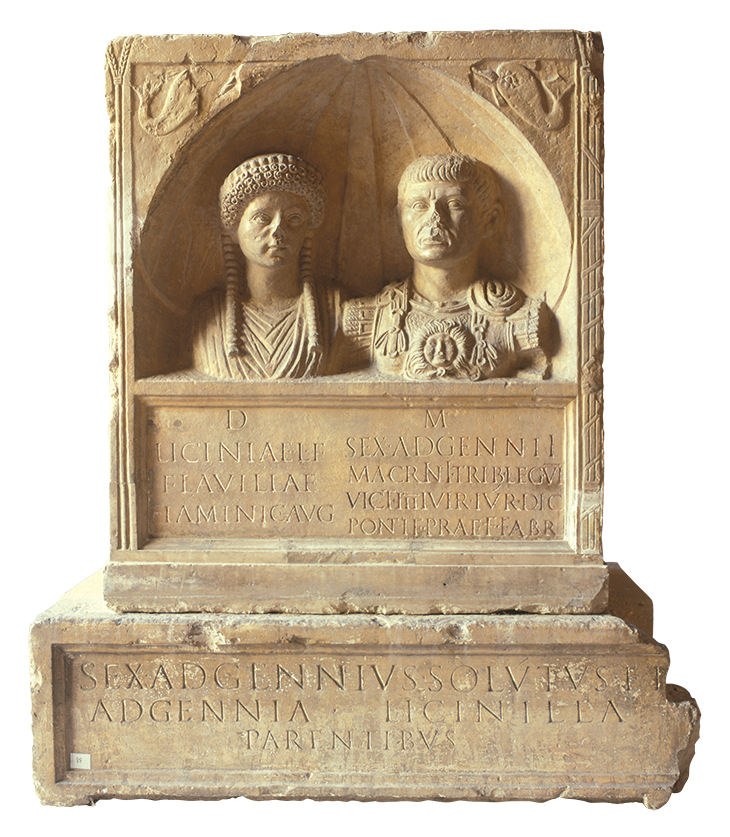
Funerary monument of Licinia Flavilla, priestess of the imperial cult, and her husband, Sextus Adgennius Macrinus (1st century AD), excavated in the 19th century on the Boulevard des Arènes. Musée de la Romanité, Nîmes
For all such spectacle and gadgetry, however, the smaller, more unassuming exhibits often have the greatest impact. (The fact that several of the ‘interactive’ elements were malfunctioning on my visit played to my natural scepticism of such museum gimmicks – though laser illuminations picking out stone inscriptions are a nice touch, as if the words are being etched as you watch.) So rich is the museum’s numismatic collection that the safes in the reserves, I’m told, weigh three tonnes when full. Two hundred of the most legible and significant coins are beautifully displayed here – including several versions of the As de Nîmes. An exceptional collection of coloured glass urns came from a tomb, thanks to which even the lids and beautiful scrolled handles are, unusually, intact. The epigraphic collection, one of the largest in France, includes funerary steles detailing the careers of magistrates, ex-slaves (and ex-slaves who have gone on to become magistrates), even a gladiator from Alexandria – a whole cross-section of society. Some of those funerary monuments feature sculpted portraits of the deceased, bringing individuals to life still more vividly. One such is a couple, Licinia Flavilla, a priestess of the imperial cult, and her husband Sextus Adgennius Macrinus – also a priest, as well as a military commander and a civil official. He wears a cloaked cuirass, she a tightly ringleted Flavian coiffure that helps date the monument to the late first century. And then there’s the evidence of daily life, the objects that bridge millennia: a polished-bronze hand mirror; a pair of tweezers; a child’s rattle in the form of a wild boar; a tiny bronze mouse on the spout of an oil lamp.
When Dominique Darde first arrived in the Gard region some years ago, she was struck by the strong sense of connection to the past. ‘In the large rural areas,’ she explains, ‘I met extremely cultivated people who proudly expressed the link they still had with antiquity. They would show me ceramic fragments that they had discovered during ploughing. They regarded themselves as the Romans’ descendants.’ Looking at these familiar, intimate objects, it’s easy to see why.
From the February 2019 issue of Apollo. Preview the current issue and subscribe here.
Unlimited access from just $16 every 3 months
Subscribe to get unlimited and exclusive access to the top art stories, interviews and exhibition reviews.


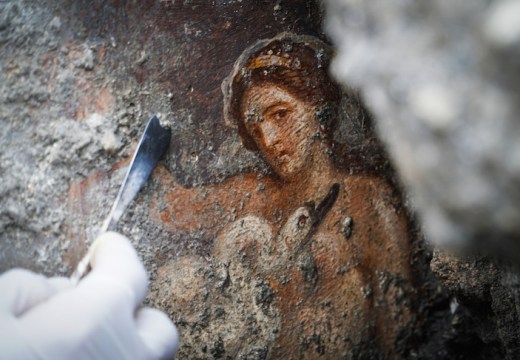
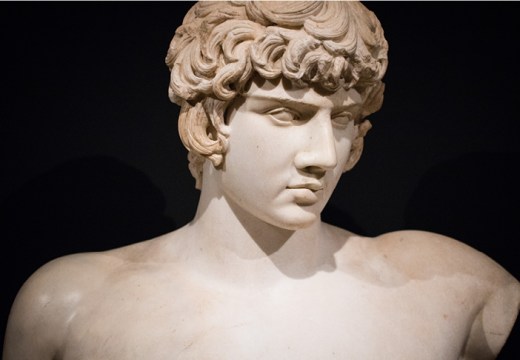
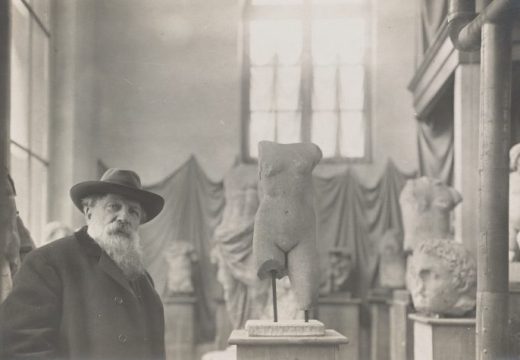









![Masterpiece [Re]discovery 2022. Photo: Ben Fisher Photography, courtesy of Masterpiece London](http://www.apollo-magazine.com/wp-content/uploads/2022/07/MPL2022_4263.jpg)
It’s time for the government of London to return to its rightful home